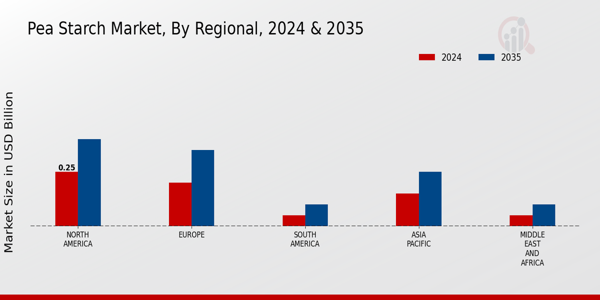Rising Health Consciousness
The increasing awareness of health and wellness among consumers appears to be a pivotal driver for the Pea Starch Market. As individuals seek healthier dietary options, the demand for plant-based ingredients, including pea starch, is likely to rise. Pea starch is perceived as a nutritious alternative to traditional starches, offering benefits such as lower glycemic index and higher protein content. This trend is reflected in market data, which indicates a steady growth rate of approximately 6% annually in the consumption of plant-based food products. Consequently, manufacturers are responding by incorporating pea starch into various food applications, thereby enhancing the appeal of their products to health-conscious consumers.
Versatility in Food Applications
The versatility of pea starch in various food applications is a notable driver for the Pea Starch Market. Its functional properties, such as thickening, gelling, and stabilizing, make it suitable for a wide range of products, including sauces, dressings, and dairy alternatives. Market data suggests that the food sector accounts for a significant portion of pea starch consumption, with projections indicating a compound annual growth rate of 5% in this segment. This adaptability not only enhances product formulations but also allows manufacturers to cater to diverse consumer preferences, thereby expanding the market reach of pea starch.
Sustainability and Environmental Concerns
Sustainability has emerged as a critical consideration for consumers and manufacturers alike, influencing the Pea Starch Market. The environmental impact of food production is prompting a shift towards sustainable sourcing and processing methods. Pea starch, derived from legumes, is often viewed as a more sustainable option compared to conventional starches, which may require intensive agricultural practices. This perception is supported by data indicating that pea cultivation has a lower carbon footprint. As consumers increasingly prioritize eco-friendly products, the demand for pea starch is expected to grow, with manufacturers likely to highlight the sustainability of their sourcing practices to attract environmentally conscious buyers.
Growth of the Vegan and Vegetarian Segments
The rise of vegan and vegetarian diets is significantly influencing the Pea Starch Market. As more consumers adopt plant-based lifestyles, the demand for ingredients that align with these dietary choices is increasing. Pea starch serves as an excellent alternative to animal-derived ingredients, making it a preferred choice in vegan formulations. Market analysis indicates that the plant-based food sector is experiencing rapid growth, with projections estimating a market size increase of over 10% in the coming years. This trend is likely to drive the demand for pea starch, as manufacturers seek to innovate and create products that appeal to this expanding consumer base.
Technological Advancements in Starch Production
Technological advancements in the production of starch are playing a crucial role in shaping the Pea Starch Market. Innovations in processing techniques, such as improved extraction methods and enzymatic treatments, are enhancing the quality and functionality of pea starch. These advancements not only increase yield but also improve the sensory attributes of the final products. Market data indicates that investments in research and development are on the rise, with companies focusing on optimizing production processes to meet the growing demand for high-quality pea starch. As these technologies evolve, they are likely to further propel the market, enabling manufacturers to offer superior products that meet consumer expectations.


















Leave a Comment